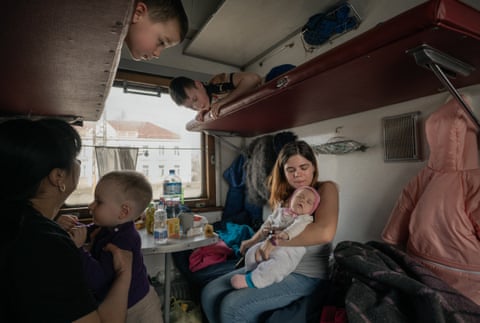Windows shuttered and lights dimmed, a darkened train pulls into a station platform, also unlit. As the train comes to a halt, carriage attendants toss boxes of humanitarian aid to station workers waiting on the platform.
Huddles of passengers, who arrived at the station hours earlier so as not to be on the streets during curfew hours, search in the inky blackness for the right carriage, before the train is on its way again with a gnashing of wheels and a long hiss of steam.

Refugees arriving in Lviv on evacuation trains from Kharkiv and Kryvy Rih make their way through the train station

Refugees struggle to get on to the evacuation train from Lviv to Przemyśl, Poland, as authorities inspect their papers. The women and children in the family make it on to the train, while the men do not.
This scene has played out at stations across Ukraine repeatedly over the last month, as Ukrainian Railways has been engaged in one of the most impressive elements of Ukraine’s war effort. Several million people have travelled west to safety on evacuation trains, while the carriages have returned east packed with tonnes of humanitarian aid.

Refugees wait at the border crossing of Medyka after crossing into Poland. Most travel to Lviv by evacuation train; from there they either take another evacuation train to Poland, or they go by bus or car to the Polish border. Once they have crossed the border on foot, buses are available to bring them to the nearest town Przemyśl.
Ukrainian Railways employs more than 230,000 people, and almost all its employees have stayed in the country to work, according to Oleksandr Kamyshin, the company’s CEO. While stations in the areas under Russian occupation are now closed, the trains have continued running even to cities like Kharkiv, which has been under constant Russian fire.
Since the war started 64 employees have died and 71 have been injured, he said, counting incidents at work and those at the homes of employees.
“If the track is blown up, we repair it. If we can get somewhere, we go. It may be dangerous for our staff, but then that train can save thousands of other people from danger,” said Kamyshin, in an interview at Kyiv’s central station. He and a small “mobile command centre” of seven people has spent the last month crisscrossing the country on trains, to show support for staff working in all parts of the country.
“We have several special carriages for our use, but we don’t use them outside the west of the country because the Russians may be able to identify them,” he said.
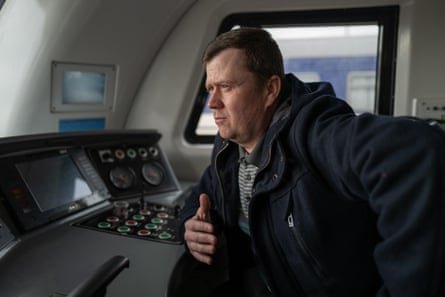
Viacheslav Chumak, 43, who runs the evacuation train from Kyiv to Lviv.
“I work for the Ukrzaliznytsia from 1996 and I have travelled all over Ukraine: Kyiv-Lviv, Kyiv-Kostiantynivka, Kyiv-Dnipro, Kyiv-Kharkiv. I am feeling a sense of anxiety from doing my job. How can you look at the children’s eyes, who are scared, and at their mothers, who are going nowhere. Their soul is torn and their heart aches. As a train driver I see what is going on.”
At the peak of the evacuation programme, 200,000 people a day were travelling west, on trains that were made free of charge for everyone, with women and children having priority.
There were heartbreaking scenes at Kyiv’s central station during the early part of the war, as residents feared the capital could face the same fate as Mariupol, Kharkiv and other cities and scrambled to get out as quickly as possible. The trains were often crowded, uncomfortable and sweaty inside, but they did the job. In the first two weeks of the war alone, 2 million passengers were taken to safety.
Dmytro Yaroshenko, 36, has been working on the railway since he was 20. He is now the train manager on the 82 train, running between Uzhhorod in the far west, on the Slovakian border, and Kyiv.
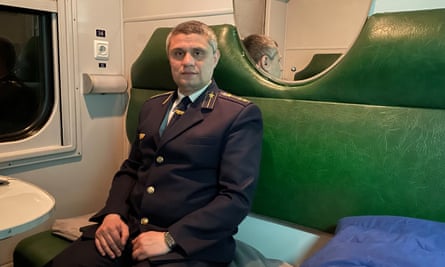
Ukrainian train manager Dmytro Yaroshenko on board his Uzhhorod-Kyiv train.
“We turn the lights off for the section of the journey around Kyiv, and anywhere that might be dangerous, as well as if the train stops. Who knows who might be hiding in the bushes,” he said, on a recent journey towards the Ukrainian capital.
He said he had no qualms about continuing to work during wartime, and saw his own role as part of the overall Ukrainian war effort.

Tetjana, 36, and her daughter Sofia, 5 from Sumy, a city that has been under attack by Russian forces since the beginning of the invasion. Tetjana was working as a train conductor on evacuation trains but for the sake of her daughter’s safety she says she now decided to flee the country herself. She was the last person to leave the apartment building in which they were living. They are on their way to Przemyśl in an evacuation train themselves, which is at a stop in Lviv.

A carriage reserved for children with special needs in the evacuation train from Kryvyi Rih to Chop. The train ride took two full days. During the night, the lights were switched off so the train would not be visible to Russian forces.
“It’s painful that our soldiers, our women and children are dying. But nerves and hysterics don’t help. At these times it’s better to get a grip of yourself and stay calm,” he said.
Working the trains is a way of life in Ukraine, and Yaroshenko talks about his team with genuine pride. The number 82 is “one of the best” in the country, he said. He wore a smart navy uniform with gold buttons embossed with the Ukrainian trident.
“I have 25 carriage attendants, and we’re like a family. We have New Year’s parties together, we have our own group on Viber. They need to look at their boss and take an example from me that I’m not panicking,” he said. On his days off, he helps guard a checkpoint near his home village.

Eugen Zagoruk, train driver on the route Lviv – Przemyśl. “I run the evacuation train in the western direction. To the stations Mostyska, Sambir, Syanky, Lavochne, Mukachevo and Uzhhorod. The journey from here to Poland takes 21 hours, and they already traveled from the east for who knows how many hours. When we arrive in Poland, they still have to go somewhere else and it is impossible to know how many hours that will all take.”

Evacuation train driver Eugen Zagoruk gets the final call with permission to leave the station for Poland with a full evacuation train.
The train manager is responsible for ensuring the safety of the journey and the passengers, a role which has taken on added meaning in wartime. Before each departure, Yaroshenko checks various WhatsApp and Telegram groups where train operators share the latest intelligence. Last Thursday, he was alarmed by reports that a train had come under fire near the town of Vasylkiv outside Kyiv, and several windows had been blown out.

Roman Gasyuk, an evacuation train diver, in his cabin at a stop in Lviv doing final checks before departure to Przemyśl, Poland. “I’m doing evacuation routes from Lviv to Przemyśl. Lviv can not provide enough beds for refugees and while Europe is accepting them we need to give them the opportunity to reach safe place during the war. Yes, our profession is kind of dangerous because we might have attacks on the way, but still I think that risk is low because our territorial defence units are looking after our safety, controlling all bridges and all securing the vulnerable places.”
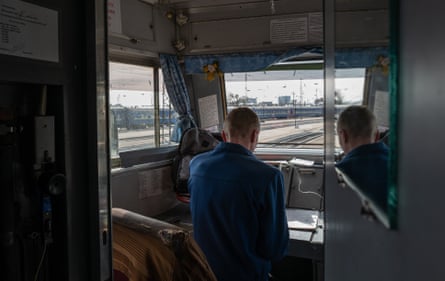
Train driver Gasyuk’s assistant is filling in the log on their stop in Lviv central station.
It transpired that, in fact, a Russian missile had hit a nearby fuel storage depot, and the shock waves had smashed the windows. The track was undamaged, and Yaroshenko’s train could run as scheduled.
As the war has ground on, small things have changed: there is no longer fresh bedding in the sleeping carriages, because some of the places they were laundered are now under Russian occupation.
Almost every train is late arriving, because they stop to load and unload humanitarian aid, and have to wait outside large cities if air raid alerts are sounding when they are due to pull in. Their top speeds have been reduced, so that in the case of sabotage, accidents would be less likely to be fatal.
But, remarkably, most trains continue to run.
In recent years, Ukrainian Railways has undergone a programme of significant reforms, and installed a young, western-educated management team. Kamyshin is just 37. However, he said the necessities of war period had forced him to return to some of the old ways.
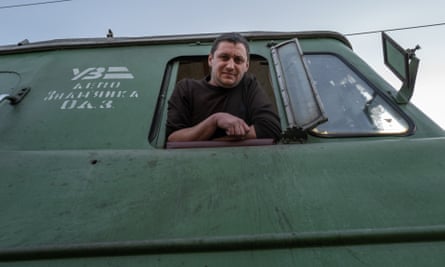
Olexiy Stasenko, 31, runs the evacuation train from Zhmerynka, Ukraine. His family remains in Zhmerynka. When asked if he is planning to evacuate them he says: “Why? Why would I evacuate them? If we leave, who will be here to protect our country?” His longest route was 17 hours. Then they rest for 6 hours and go again. “Today we are doing the evacuation route from Zhmerynka, we departed at 06:24 am. We will have a rest now and then we will be driving back. We have huge amounts of passengers, everyone is leaving. For sure it’s dangerous, but we were are well prepared for it.”
“We had implemented European stuff and became a place of discussions rather than decisions, we lost this vertical command culture. In wartime, we brought it back,” he said, adding that some of this speedy decision making would be retained after the war was over.
Kamyshin said the evacuation programme is now “basically done”, and the focus of the railway leadership is now on helping to build export and customs capacity on the country’s western borders to increase rail exports, after the Russian advance has put Ukraine’s southern ports, which handle much of its export trade, out of action.
“Once the ports are unblocked the cargo will flow through them again, but we will still have this crazy neighbour. And this crazy neighbour could make problems for years. So we need to develop these western corridors, and have them as Plan B, with the option to extend them significantly at any moment.”

Evacuees from Eastern Ukraine rest in a tent set up at a platform in Lviv’s central station.
